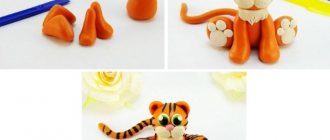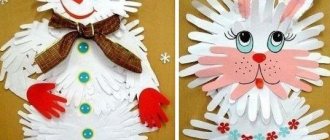Examples of finished works
Children put their finished work on the table so that the teacher can evaluate their talent. Most often, children like to draw images on the theme “Defender of the Fatherland Day”, “March 8”, “Autumn”, “Spring has come”, “The coldest month”, “Profession”, “Forest”, “Why day follows night”, “Clothing” ", "Our kindergarten is like a home."
Works of preschoolers
The most popular theme for children is “Headdress”. The children learn to correctly name hats and their parts, telling what types they come in. For example, to come to the beach, you need to wear a Panama hat and a hat. When late autumn comes, women wear scarves and light scarves. And already in February and January you need to wear a warm pompom.
Catchy songs for kids to make dancing fun
Summary of a drawing lesson in the preparatory group: Khokhloma
Summary of a drawing lesson in the preparatory group “Golden Khokhloma.
Painting a plate based on Khokhloma painting” (made using non-traditional techniques: wax pencils and watercolors). Author of the work: Kokorina Tatyana Nikolaevna teacher of additional education in fine arts. MBDOU No. 202 Kindergarten of a general developmental type “Fairy Tale” Description: this summary will be of interest to teachers of senior and preparatory groups, teachers of additional education in art activities, as well as simply creative people. Goal: expanding knowledge about the folk craft of Khokhloma painting. Objectives: - to form children’s understanding of the appearance of dishes in ancient times; — talk about the appearance of Khokhloma painting; — learn to consistently perform work using non-traditional techniques; — learn to beautifully place a pattern over the entire surface of the plate; - promote the development of aesthetic taste; — promote the development of fine motor skills of the hands, through drawing small curls; — to cultivate interest in Russian folk crafts and pride in our craftsmen; — cultivate interest in drawing through the use of unconventional techniques. Preliminary work: studying dishes and folk crafts in classes on the world around us. Methodological techniques: story, conversation-dialogue, visual material, practical work. Progress of the lesson: Teacher - Every day we use different utensils: kitchen, dining, tea. These dishes are metal, porcelain, glass. There are dishes that we use every day, and there are beautiful holiday sets that are taken out only on holidays to set the table. Do you know how the dishes appeared? Dishes appeared a very long time ago. At first, ancient people used tree bark to, for example, scoop up water or nut shells. They tried to hollow out vessels from stone and wood. Sea shells were used as spoons; they were convenient for scooping up food. Gradually the dishes were improved. People learned to make dishes from clay and fire them.
And of course, since ancient times, people have tried to make dishes not only convenient for use, but also beautiful, therefore, from ancient times, various designs began to be applied to dishes. The first patterns were simple, they were made with thin wooden sticks, these were geometric shapes, people, animals.
So wooden dishes appeared, clay dishes - ceramic, and later people learned to make porcelain, which we use now. Wooden utensils still exist today, but now they are more often used to decorate the interior. Beautiful, bright, it stands on a shelf or in a closet and pleases the eyes with its unique pattern. Do any of you know what this dish is called? Children - Khokhloma.
Educator - Correct. This wooden dish is painted with floral patterns. What does vegetable mean? Children are grass, flowers, berries. Educator - Yes, these are all kinds of plants: grass and leaves, berries, flowers with beautiful curls. According to legend, this painting was created by a talented master, icon painter Andrei Loskut. He worked for the king and he generously rewarded him for his work. But the master loved freedom most of all. One night he left the royal court and went to live in the forest. Andrey wanted to paint not only icons. He dreamed of creating something simple, necessary and at the same time beautiful, like the native nature around him. This is how the first wooden utensils appeared. And since the master lived in the forest, he began to paint it with flowers, berries, leaves, and twigs. The fame of the amazing master reached the surrounding lands. Many came to him to see this dishes, some stayed forever, wanting to learn how to create the same wonderful products. Andrey Loskut passed on the secrets of his skill to his fellow villagers; his skill has been preserved, pleasing the eyes and souls of people to this day. And since all this was in the village of Khokhloma, the painting began to be called Khokhloma. This painting is distinguished by obtaining a golden color without the use of precious metal. That’s why they often say “golden Khokhloma”.
Now we will paint our plates based on Khokhloma painting. For this we will need: - yellow and red wax pencils; - black watercolor; - wide brush No. 5 or No. 6. 1.first, using a yellow wax pencil, draw three leaves at the bottom of the plate.
2. Using a red wax pencil, we draw three large strawberries over the yellow leaves.
3.Draw droplet leaves between the berries with a yellow pencil from smallest to largest.
4.Draw curls between the lower leaves
5.add small flowers and curls at the top.
6. Paint the entire plate with black watercolor.
The plate painting based on Khokhloma painting is ready.
We recommend watching:
Unconventional drawing technique Blotography. Master class Summary of GCD in the senior group Khokhloma painting. Master class for 2nd-3rd grade students Summary of GCD in the senior group. Golden Khokhloma
Similar articles:
Painting a cutting board. Khokhloma
Painting a Khokhloma plate
Drawing autumn leaves, grades 1-2
Summary of a lesson in the preparatory group of a kindergarten on the topic Vitamins
Summary of the direct educational activity “Music” in the preparatory group




